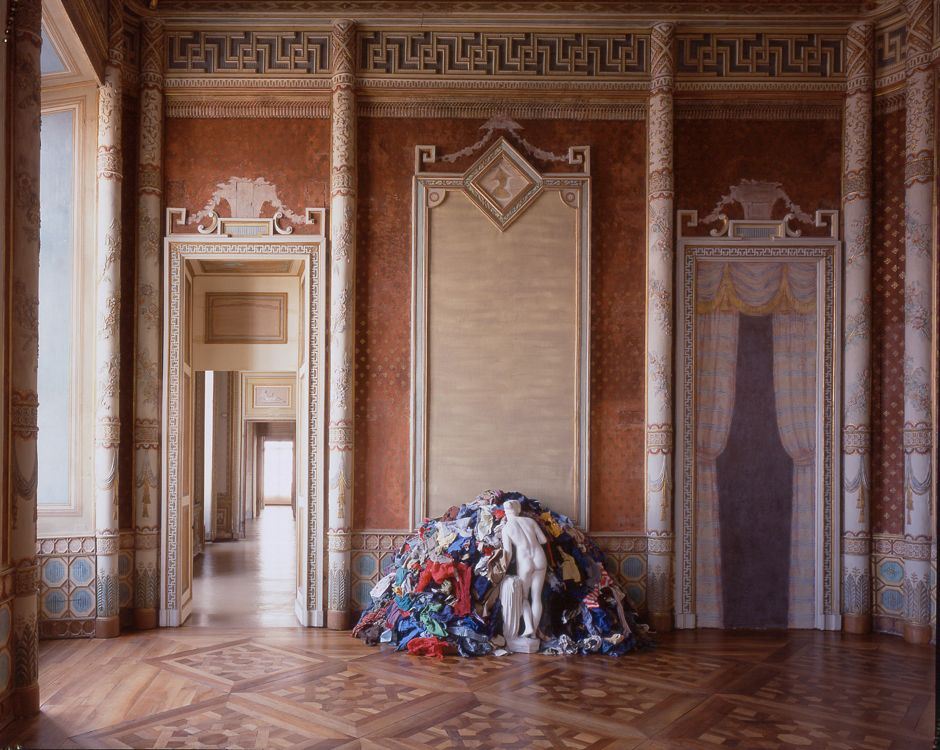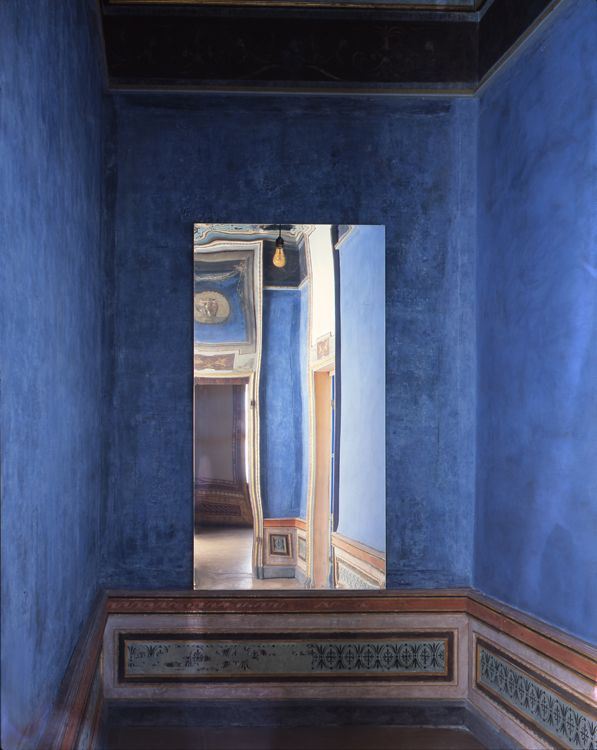Michelangelo Pistoletto
Michelangelo Pistoletto ’s art aims to connect artistic experience and everyday life, with the aesthetic goal of moving beyond the boundaries of the work, to bring art into life and life into art. His apprenticeship in his father ’s restoration studio, along with his experience at an advertising graphics school founded by Armando Testa, in which his mother enrolled him, marked the beginning of Pistoletto ’s career as an artist and influenced his future aesthetics. Having received his training far from academic circles, he was affected by the postwar climate of alienation and existential anguish, and he recognized in the paintings of Francis Bacon, whose work he saw in an exhibition at the Galleria Galatea in Turin, elements that were common to his own thinking about the human figure and its relationships with the world. In the early 1950s he began to explore the nature of personal identity and turned to the self-portrait as the emblematic expression of his ideas.
Man is central to his interest —a modern man in search of dimension and space. Pistoletto identified the resolution of the problem of the background field, namely the setting behind the figure, as a central issue to be investigated, and the point of departure for the reconstruction of a dimension in which the human figure might be placed. In 1961 he produced Il presente (The Present)—his first reflective painting —in which his own life-size self-portrait stands out against a black background made reflective through the application of high-gloss acrylic paint. But the true protagonist is the relationship of instantaneousness that is created between the viewer and his or her reflection on the canvas. This work opened the way to an exchange of relationships and perspectives, in which art penetrates the world and allows itself to be penetrated by the world, determining a new space-time dimension. Pistoletto would subsequently perfect his reflective-painting technique, replacing the canvas support with a sheet of mirrored stainless steel, on which he applied images of people or objects, first taken from life-size photographs and painted on tissue paper,and then,beginning in the 1970s,using silkscreen. Some of the works in the Castello ’s collection —including Ragazza che cammina (Girl Walking),and Lampadina (Lightbulb),both 1962 –66 —come from this period, and in these examples reality and representation merge in the dialectical exchange occurring on the surface. For Pistoletto, moving beyond pictorial boundaries created access to a landscape that opens up onto contemporary life.
In Venere degli stracci (Venus of the Rags),1967,the reproduction of a Greek statue, the Callipigia Venus,a metaphor for memory, relates to a multicolored pile of discarded garments,symbolizing everyday life, in a dense dialogue between past and present. The rags, taken as pictorial elements, represent everything that passes, the transformation of matter, the transitory. But they also have an ideological component as the product of a consumer society and indicate its growing number of poor people.
Meanwhile, the cement copy of a classical Venus, covered in mica, an extremely luminous material, is a formal element that refers to an immutable beauty. With this work, Pistoletto indicates another way of looking at art from the past, using history to recontextualize this figure, the face of which is rooted in contemporary existence and the physicality of the present.
In the 1980s the artist began investigating sculpture, which has been an abiding interest. Sculpture allowed him to further develop the relationship between past and present, in a dialogue between memory and reality that runs through all of his work. Onda di bronzo (Bronze Wave),1982 –83, is formed from numerous pours of metal, which are spread over the floor and then assembled into a single structure.
The material ’s expressive potential is achieved by the flatness of the surface, which, renouncing its three-
Dimensionality ,opens up to suggestive views that seem to evoke the waves of the sea. In 1984 Pistoletto created Persone nere (Black People) out of polyurethane foam, a material he had already used for other pieces because of its speed of execution and lightness. The barely sketched-out figures extend upward, finding their true dimension in the verticality and complex rotation of the bodies. The monumental nature of the sculpture is betrayed, however, by the nonexistent weight of its material, in a dialectic of opposites that has always fascinated the artist.
Polyurethane assumes all imaginable forms as fragments of a revived past; it restores the memory of classical sculpture that lies buried in the collective imagination and positions it in a modern space. This exploration of the solids and voids is also relevant to the artist ’s works in marble, which relate to the outdoor environment. Figura che guarda nel pozzo (Figure Looking in the Well),1983 –84, previously located in the courtyard of the Casa Aurora, headquarters of the GFT Group in Turin, is a work in red Verona marble, about six meters high, and made up of smooth and worked planes that form the image of a person focused on looking at something or someone, it is an investigation of how volume unavoidably grants sculptural objects a new sense of space.
L ’architettura dello specchio (Architecture of the Mirror), 1991,continues to explore the idea of the mirror and the principle of reflectivity, a fundamental point of reference for all of Pistoletto ’s work, presenting a different aspect of this line of questioning, one with a critical dimension.
Conceived for a specific site,the Centre d ’Art Santa Mònica in Barcelona, the work merges the dimension of real time, already addressed in previous works, with the dimension of the architectural space to which it relates. The surface of the four-part mirror, of which the work is composed, is understood as a symbol of the universal container: it does not accommodate any painted image because it potentially reflects all images. In this work, unity, division, and multiplicity intersect. The gilded frame that contains it, typical of paintings, functions to maintain the unitary sense of the object. This work relates dynamically to time and marks the passage from a historical dimension, the cloister of an old monastery, to a contemporary one, the place ’s new use as an exhibition center. This is the beginning of a new reflectivity, based on the multiplication
of the surface, where, through the use of the mirror, memory comes into play in relation to the space, as the identification of the etymology of the words “memory ” and “mirror ” suggests.
In primo luogo (In the First Place),1997,again draws on classical sculpture, attesting to the circularity of Pistoletto ’s ideas. The installation, inside a building in the center of Turin, becomes an integral part of the work, which includes the second version of an earlier work, L ’Etrusco (The Etruscan),a plaster copy of a famous antique bronze statue, L ’Arringatore (The Orator),a portrayal of Aulus Metellus in the midst of a discourse. Located in front of a mirror, an arm raised toward it, this figure indicates a double direction and a double perspective, where both the depth of the work and its foreground establish a dialectic of antinomies that is so often part of Pistoletto ’s art.
[GC]








